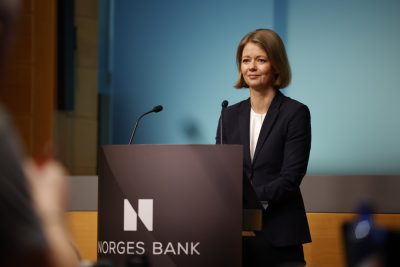Norway’s key interest rate rose again on Thursday and the price of the country’s North Sea crude oil is higher than it’s been in years. Both factors generally strengthen Norway’s currency, the krone, but it remains unusually weak even as Norway’s central bank warned of yet another rate hike in December.

The central bank’s warning surprised all the Norwegian economists who’ve been predicting that Thursday’s hike in its policy rate, from 4- to 4.25 percent, would likely be the last for quite a while. It was the latest in a string of policy rate hikes, all aimed at curbing inflation. Several economists at local banks and investment firms have been telling Norwegian media for weeks that rates would top out and may even start to decline.
Not yet, with Norges Bank Governor Ida Wolden Bache stating that “there will likely be one additional policy rate hike, most probably in December.” She’s still worried about inflation, even though it dipped to 4.8 percent in August and was lower than economists at state statistics bureau SSB had expected. The core inflation rate (excluding recent declines in energy rates and changes in state fees) landed at 6.3 percent. That left both sets of inflation rates still “markedly” above the central bank’s inflation target of just 2 percent.

Bache and the central bank’s committee that sets rates also noted that growth in the Norwegian economy has slowed, business costs have “increased considerably” and labour costs “are expected to increase more than projected earlier.” That, according to the committee, “will contribute to keeping inflation elevated.” They don’t want it to become entrenched, prompting the bank to become more “aggressive,” as economist Bjørn Roer Wilhelmsen of Norkinn Asset Management told newspaper Dagens Næringsliv (DN).
Norway’s key policy rate will thus “lie around 4.5 percent through 2024,” according to the central bank itself, because of a need for what Bache calls “a tight stance for some time ahead.” Home mortgages will thus probably rise up to 6.5 percent, putting more pressure on households with large loans tied to the high real estate prices of recent years.
The housing market has already cooled off, with some real estate brokers reporting declines in sales and prices, and some homeowners finding it difficult to unload their properties. Norway’s recently hot market for holiday homes (hytter) along the coast and in the mountains has all but frozen, new car sales have crashed and boat sales that surged full steam ahead during the pandemic have sunk.
Food prices in Norway, already among the highest in the world, have risen three times as high as in the EU, by 11 percent so far this year. A trip to the grocery store in Oslo can leave customers groaning in the aisles, or even laughing out loud over tomatoes that cost NOK 67.9 per kilo (around USD 3 per pound) this summer, or loaves of bread all priced at well over USD 5 even when it costs NOK 10.7 to buy a dollar. At a more historically “normal” exchange rate of NOK 7.5 to the dollar, for example, the same bread would cost more than USD 7.
Unemployment rates have also risen a bit, but remain far below historic averages at around 2 percent depending on various calculations. Low unemployment is also raising employers’ costs because they need to offer higher wages in order to attract needed workers and talent.
While last winter’s high electricity rates, higher interest rates and price growth have forced tightening of many household budgets in Norway, and increased lines at food banks, restaurants remain busy and airlines flying to holiday destinations are often full, even though SSB reported that airline ticket prices have risen 55 percent over the past year. The good times seem to keep rolling for many, with Lars Eivind Haartveit, chief economist at employers organization Virke, attributing that to savings built up during the Corona crisis when it wasn’t possible to travel or have a night out on the town.
It remains unclear, Haartveit told newspaper Aftenposten, how long consumers’ savings will last. Credit card debt has been rising, too, and in May of this year, consumption fell for the first time since the pandemic eased. Retail sales were down and Norway’s largest bank, DNB, reported “a clear shift” in spending patterns. A combination of bad weather both in and outside Norway also left many Norwegian opting to stay home for summer holidays instead of traveling abroad, also because the Norwegian krone was so weak against other currencies, especially the US dollar and the euro.
The krone remains weak, with one US dollar costing more than NOK 10.822 and a euro costing NOK 11.512 four hours after the interest rate increase was announced. That compared, for example, to NOK 10.75 for a dollar when the rate hike was announced.
Bache, leader of the central bank, said in June that she thought a majority of Norwegians would be able to handle interest rate increases. She still does, but cautions of ongoing “uncertainty about future economic developments.” If pressure on the economy persists and the krone turns out to be weaker than projected, the central bank noted, inflation could remain high for longer than expected.
“In that case, we’re prepared to raise the policy rate to a further extent than we project at present,” Bache said. If there’s a slowdown in the Norwegian economy and inflation declines rapidly, with some economists already warning of recession, rates may come down. The bank’s next interest rate decision is due in November.
NewsinEnglish.no/Nina Berglund

